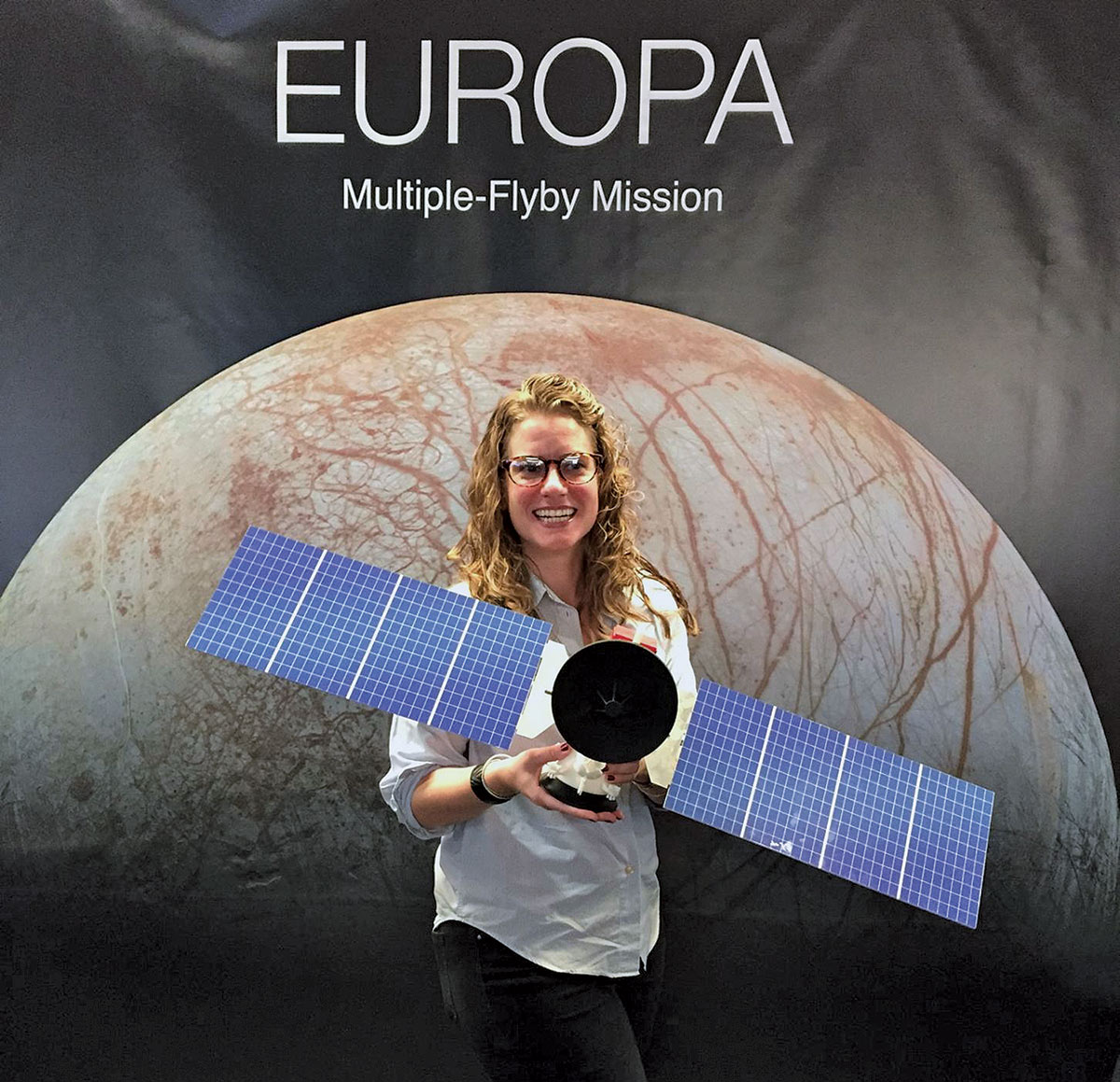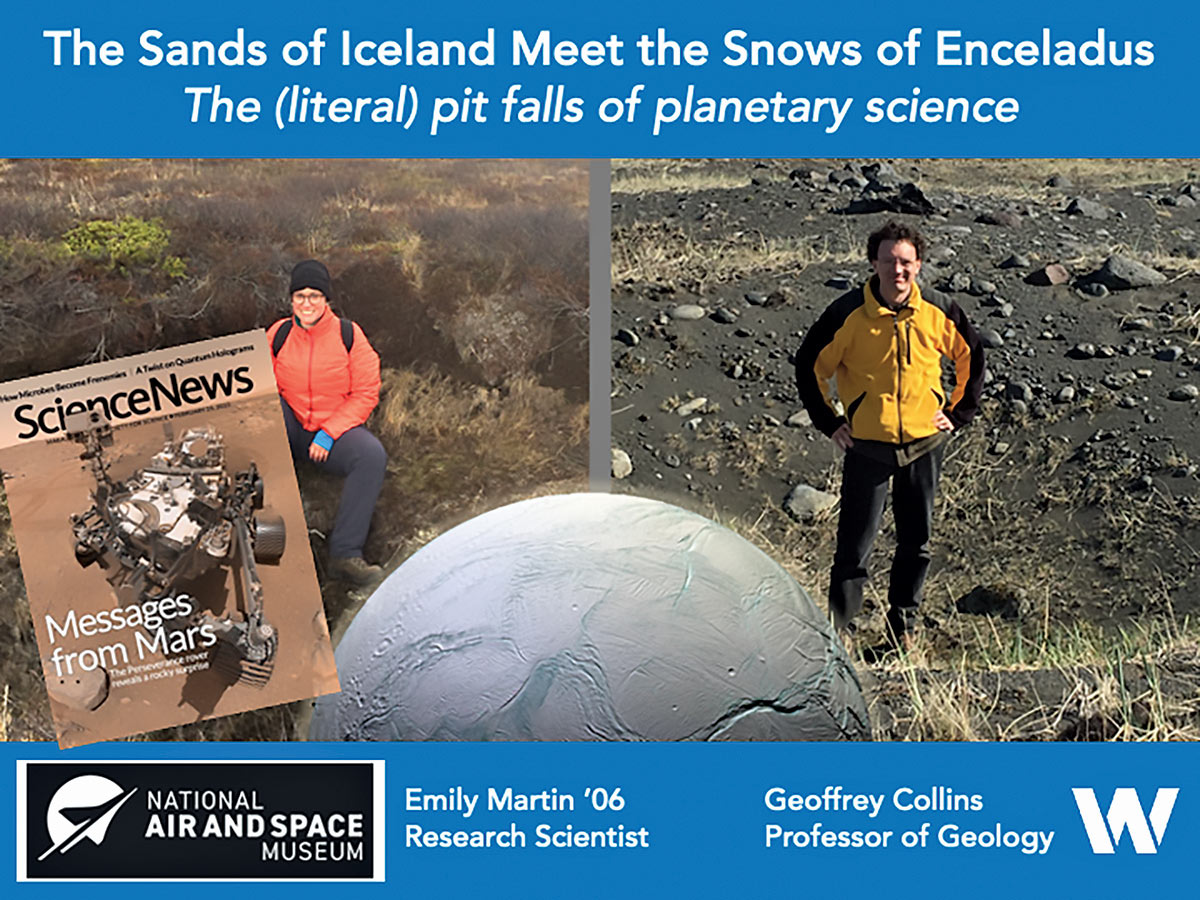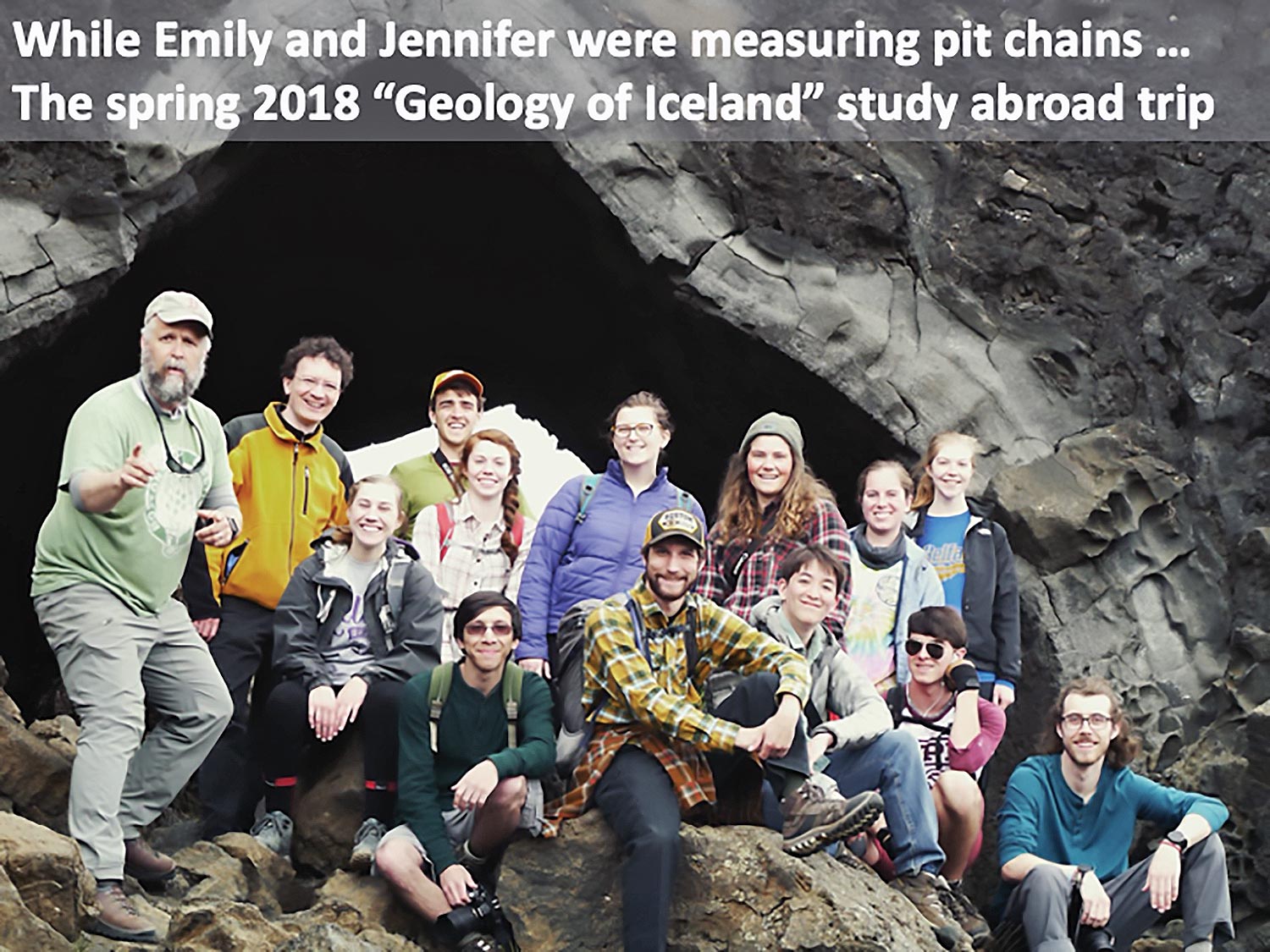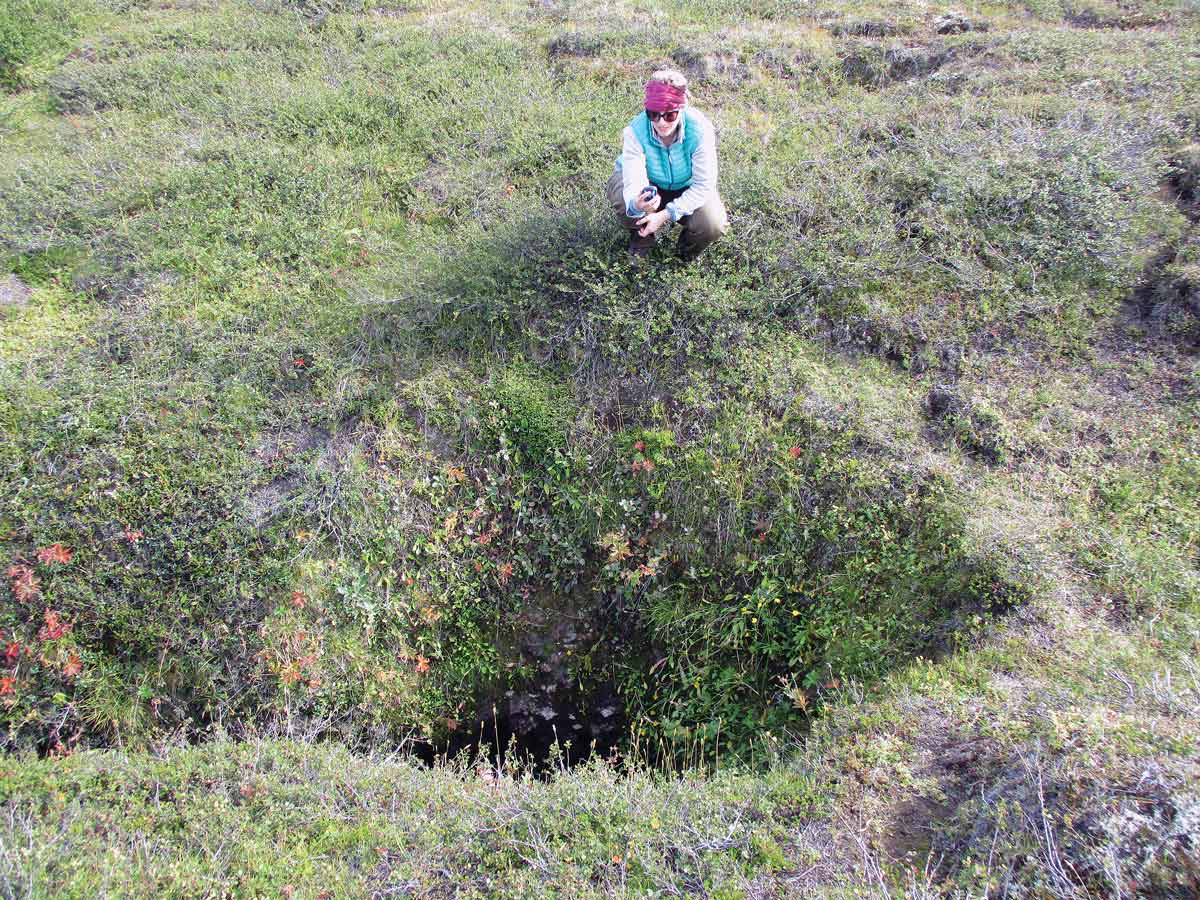Out of this world

Emily Martin ’06 credits her Wheaton experience with launching her career in the study of the solar system
For some, the path to college and through to a career is a straight line. For Emily Martin ’06, it has been a meandering journey. That is perhaps fitting given that now, as a research geologist in the Center for Earth and Planetary Studies (CEPS) at the Smithsonian’s National Air and Space Museum in Washington, D.C., she spends her days exploring the unknown.
“I feel like many kids of my generation spent a lot of time figuring out how to get to college,” she says, “but we didn’t spend a lot of time figuring out what we were going to do once we got there.”
Martin has worked at CEPS since 2014 (having done her postdoctoral work there, too), where her research focuses on the geology of the icy planets and moons of the outer solar system. She says her experience at Wheaton, especially with its strong emphasis on the liberal arts, was pivotal in shaping her career.
When she arrived at college, she spent most of her time navigating the core courses—freshman seminars as well as writing and language courses. She considered pursuing the social sciences.
“I just wanted to try different things and see what stuck,” she recalls.
She ended up taking a course on the solar system that then led to a course about the universe, where she met the head of the Physics Club.
“I wouldn’t have ever considered a physics major—like, never—but there was a really strong sense of community in that department within the faculty and the students. And I thrive in those environments.”
It was in this supportive community that she met Professor of Physics John Collins, who became her academic advisor and an important influence in her educational experience at Wheaton.

“He was holistic in his approach to helping me define my next steps and identifying my strengths and interests,” she says. She ended up majoring in physics with a minor in astronomy.
After taking a semester to study abroad in Madagascar (study abroad opportunities were one of the reasons she chose Wheaton), Martin returned and took a summer internship at Lowell Observatory in Flagstaff, Ariz. This created one of the forks in her non-linear career trajectory; it was there that she realized she did not want to pursue astronomy.
“Astronomers don’t look through a telescope, not the way you think they do,” she says, explaining that she’d had visions of herself staring into the night sky at glorious images like those being returned by NASA’s Hubble Space Telescope. The reality was not so glamorous. “I didn’t enjoy spending all night staring at a computer that was talking to the telescope.”
New horizons
After her Arizona internship, another formative experience awaited—this one with Geoffrey Collins, professor of geology. He was testing software to sequence the timeline of events that took place on Jupiter’s moon, Ganymede, and had funding for a research intern. He recalls that Martin jumped into the project with enthusiasm, helping create a global map of that moon. The internship allowed her to transition from astronomy into planetary science.
But having chosen this path late in her academic career, she was behind in her field of study. After college she took a gap year. She received a master’s degree in Earth and planetary science from Northwestern University and, inspired by that research on Ganymede, pursued a Ph.D. in geological science at the University of Idaho with an emphasis on the outer moons of the solar system.
When her graduate advisor went on sabbatical, Martin moved to Washington, D.C., to be with her partner. He suggested she get a desk at the National Air and Space Museum and work on her dissertation from there, rather than working at home. The choice proved fortuitous as she met not only interesting people there, but colleagues who encouraged her to do her postdoctoral work at the museum.
“It felt much more linear at the time, but in hindsight there was a lot of back and forth and travel trying to figure things out,” she says. “There were a lot of people who really motivated me to think about things that I hadn’t thought about before and who really encouraged me to take opportunities that I hadn’t considered taking. … Without any of those suggestions, I don’t think I would be where I am.”

An evolving research life
Today, in a research office at the Smithsonian’s National Air and Space Museum, she studies the geology of wild, otherworldly places. Martin explains that geology is, fundamentally, the study of how a planet changed and evolved to arrive at its current state. On Earth that means looking at how continents, valleys and mountains formed, how and when the oceans formed, and when life evolved. Planetary geology looks at the same concepts, only rather than asking “When did life evolve?” the questions are “Did it evolve” or “Can it evolve?”
Martin’s own specialty is tectonics and structural geology—how fractures and faults form on planets—of icy worlds, which she describes as “very niche but extremely rewarding.”

Currently, she’s creating a geologic map (a sort of visual history) of Neptune’s moon Triton for the U.S. Geological Survey and a similar project for Dione, a moon of Saturn. She’s also doing some work on Earth’s moon. Faults and fractures can help tell a story of what is happening to the interiors of these planetary bodies, which is of value because many of these moons may have or have had liquid oceans underneath their icy shells. Where there is water, there is the potential for life.
“We’re understanding the geologic history of these places and their interior evolution,” Martin says, “which then allows us to say this one has a high likelihood to have a habitable or have had a habitable environment such that we may have had life evolve here.”
She continues that this is important because while Mars tends to receive the most focus as a habitable planet, we have an entire solar system, all of it with more water than Mars or Earth combined, still to be explored.
Much of this research parallels work being done by Geoffrey Collins, so the former student and her research advisor continue to cross paths, most recently when Martin and a Smithsonian colleague were in Iceland studying pit chains that form along faults and fractures. While common in the solar system, Iceland is one of the few places where pit chains can be found on Earth. Collins was also in Iceland with a group of 12 students. The groups met and students worked with Martin and her field equipment to measure and study these pit chains. One student, Eammon Littler ’20, who wrote drone software that created 3D models of the terrain, was able to have his data utilized in the Smithsonian’s final research paper.
“When my former students talk to my current students, it helps to show them how you can develop your career without necessarily sticking to a straight path,” says Collins. “Students are nervous that if they don’t know what they want to do that they’ll be behind forever; Emily decided to completely switch her path and it worked out. … It’s important to have examples of people who have tried many fields of study and then found ways to apply the things that they’re good at to the science field.”
Martin says it is extremely important to her to involve undergraduate students in research. She frequently speaks with Geoffrey Collins and others about how to create appropriate, equitable and accessible opportunities for students.
“As a person who found my place by experimenting with different fields through different internships, I think it’s really hard to commit to and figure out where you fit in the professional world if you don’t have an opportunity to try on a bunch of hats,” she says.
Martin is also engaging the public on the subject of science as a co-host of “AirSpace,” the Air and Space Museum’s podcast, which covers the well-known and lesser-known of the museum’s collection and how those artifacts dovetail with storytelling and science. The podcast has covered everything from the gastronomy of food in space and how the museum hangs its huge artifacts from its ceiling to MTV’s obsession with the Moonman and historical perspectives on solar eclipses.
Whether through the podcast or conversation, Martin’s enthusiasm for her work seems insatiable. She talks about the potential in fault lines on distant icy moons like a child anticipating Christmas morning. Collins says her energy and enthusiasm are part of her gift.
“When you think about what’s important to being a research scientist, you’d think it’s only strong math or logic skills,” he says. “But many of the questions we’re after are so big they don’t fit neatly into one discipline, so the social aspect of getting people onboard, organized and excited is huge and something Emily’s really good at.”
For her part, Martin says that her interest in planetary geology resonates with her at “a cellular level,” and she thrives in a community of people who share that passion. The importance of community she found at Wheaton, the sense of how important it is to build environments and structures where people feel supported, remains with her.
“[Supportive environments] I think are critical to success for a lot of people,” says Martin. “A lot of people feel like ‘If I can’t do it on my own, it’s not worth doing.’ As far as I’m concerned, if I can’t do it within a community, then it’s not worth doing.”
